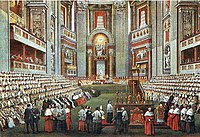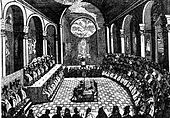| First Vatican Council | |
|---|---|
 | |
| Date | 8 December 1869 – 20 September 1870 (de facto) 8 December 1869 – 5 June 1960 (de jure) |
| Accepted by | Catholic Church |
Previous council | Council of Trent (1545–1563) |
Next council | Second Vatican Council (1962–1965) |
| Convoked by | Pope Pius IX |
| President | Pope Pius IX |
| Attendance | 744 |
| Topics | Rationalism, liberalism, materialism; biblical inspiration; papal infallibility |
Documents and statements | Two constitutions: |
| Chronological list of ecumenical councils | |
| Part of a series on the |
| Ecumenical councils of the Catholic Church |
|---|
 |
| 4th–5th centuries |
| 6th–9th centuries |
| 12th–14th centuries |
| 15th–16th centuries |
| 19th–20th centuries |
|
|
The First Ecumenical Council of the Vatican, commonly known as the First Vatican Council or Vatican I, was the 20th ecumenical council of the Catholic Church, held three centuries after the preceding Council of Trent which was adjourned in 1563. The council was convoked by Pope Pius IX on 29 June 1868, under the rising threat of the Kingdom of Italy encroaching on the Papal States. It opened on 8 December 1869 and was adjourned on 20 September 1870 after the Italian Capture of Rome. Its best-known decision is its definition of papal infallibility.[1][2]
The council's main purpose was to clarify Catholic doctrine in response to the rising influence of the modern philosophical trends of the 19th century. In the Dogmatic Constitution on the Catholic Faith (Dei Filius), the council condemned what it considered the errors of rationalism, anarchism, communism, socialism, liberalism, materialism, modernism, naturalism, pantheism, and secularism.[3]
Its other concern was the doctrine of the primacy (supremacy) and infallibility of the Bishop of Rome (the Pope),[4] which it defined in the First Dogmatic Constitution on the Church of Christ (Pastor aeternus).[5]
- ^ "Vatican Council, First" 2001.
- ^ E. E. Y. Hales, "The First Vatican Council." Studies in Church History 7 (1971): 329–344. online
- ^ "First Vatican Council" 2014.
- ^ Tanner 1990.
- ^ John W. O'Malley, Vatican I: the council and the making of the ultramontane church (Harvard University Press, 2018).[ISBN missing][page needed]